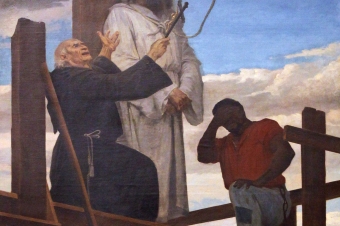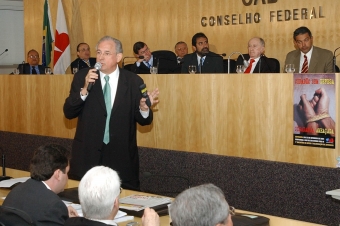Summary:
On this activity, students are invited to reflect about the main two punishment reasons that characterized the modern penal law formation since the end of the XVIII Century: return the evil caused with the evil of punishment (penal retributivism) and deter other people and the own defendant to practice the same act (penal utilitarianism). The activity is based on the classical texts reading, theoretical and written exercises coming from the movie The widow of Saint-Pierre (Pierre Laconte, 2000).
Objective:
How to justify the punishment from the penalty modern theories (retributivism and utilitarianism)? How to understand, facing a concrete case, the “punishment obligation” that marks the modern penal law from the XVIII Century? To develop these questions, the goal of this activity is to allow the students to know the penalty’s modern theories and identify its limitation up to The Widow of Saint Pierre movie script (directed by Pierre Laconte in France, 2000). The movie takes place in a Canadian island (St. Pierre), on the half of the XIX Century, where it was governed by death penalty for a homicide crime. For the penalty execution it was used the guillotine (“veuve” in French, which also means “widow” and, therefore, gave the movie title). The island did not have a guillotine, so the man convicted to death penalty was put on liberty deprivation. As he waits, the man established a great relationship with the Capitan’s wife, who kept him arrested. This relationship approximates him to the people from the island, making them change their perception about him and the crime he had done. All of a sudden, the guillotine arrives at the island. How to justify the death penalty to that man? What are the answers to the penalty’s modern theories? After reading the texts, and observing those answers, the students also look to the arsenal limit of the punish theories, and with that they open the next step of the course that is about the rehabilitation theory. The activity was designed to develop the theoretical points, the identification of his limits and obstacles before real situations. Regarding the skills, the activity privileges the oral expression in the debate and the written expression on individual exercises.
Dynamics:
- TEACHING METHOD: problem-based learning.
- REQUIREMENT: the students need to watch to the The Widow of Saint-Pierre movie before classes.
- INTRODUCTION TO THE DYNAMICS: On the day of the activity, the following The Widow of Saint-Pierre movie parts were screened on the beginning of the class:
Part 1 – Judgment and Facts
9 to 13 Minutes – Judgment
14 Minute – Crime reason indication and confession
15min10s – Sentence Reading (Show until the child announcing around the city scene)
Part 2 – Council Meeting (Governor, Navy Commissioner, Judge, and others). Governor offers forgiveness and the rest deny.
20 Minute – Council Meeting
Part 3 – Neel became hero.
54 minute – Judge was worried about Neel’s popularity around the city
1 Hour – Wedding
1 Hour and 20 Minutes – Capitan goes to the Council to ask a case review.
- DEVELOPMENT OF THE DYNAMICS: After the movie, it is proposed that the students identify on the speeches and practices presented, which ones are related to penal retributivism and utilitarism. In the end, the students individually answered the following question: Is it possible to justify the death penalty to Neel Auguste with the punishment theories that you know? Explain it.
- CLASS REQUIREMENTS: The movie is dense and in French, so it was strongly indicated that the students had the chance to watch the movie before the class, so they could understand the movie arguments and then answer the written and oral proposed questions. Additionally, It was really important that the students had understood well the reasons to punish as shown by the penalty’s modern theory.
Evaluation:
- FEEDBACK: The professor gave them the written paper commented after class. The criteria used to grade, announced on the own exercise, were:
- Objective answer to the question – “Yes or no”, “at this or another case”
- Precise reference to the two penalty theories ((retributivism e utilitarianism).
- Explanation of two or more theories statements that showed “help” or “repulse” to the possibility of justifying this concrete penalty based on theories already studied.
- Clarity and text flow.
- GRADE EVALUATION: The activity composed the course exercise’s grade. The course grade was composed by 35% of exercises, 30% group work, and 35% oral class participation. The last part was composed by (i) self-evaluation about the course performance (ii) professor indications using the class debate highlights. The highlights referred to the fundamental speech made from the class texts, and also to the connection establishment with the several readings and debates performed on previous classes.
The written exercises evaluations could have the “excellent”, “very good”, and “good”, “do it again” parameters. On the last case, the student had the chance to make the exercise again until he got the correct objectives previously asked.
Observation:
This activity closed part I (The punishment Law and Modern Punishment Rationality Formation) and, therefore, has benefited from the texts and discussions about penal utilitarism from Beccaria’s book On Crimes and Punishment and from the support text MACHADO, Maira. Beccaria and the modern penal rationality in the history of knowledge on crime and punishment, by Alvaro Pires, on Criminal Law Institutions Basileu Garcia (São Paulo: Saraiva, 2008) – see the activity on Tiradentes Sentence. Before the activity, an expositive class about the formulation of the modern punishment rationality introduced to the students the kantian penal retributivism, from Álvaro Pires’ formulations on Kant in the light of the criminal justice (chapter 4 of the book História dos Saberes sobre o Crime e a Pena, available in French)







